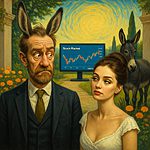
Which of the following is the biggest pitfall of economic indicators?
Dec 02, 2024
Introduction:
As we explore economic indicators, it is crucial to scrutinize their role as navigational tools in understanding the health and trajectory of economies. These statistical metrics, designed to gauge economic activity and forecast future performance, are only as reliable as the data collection methods, methodologies, and timeliness that underpin them. Yet, even when these criteria are met, the wisdom of historical economic thinkers reminds us that these indicators are not infallible. They often come with inherent pitfalls that can obscure rather than illuminate the financial landscape.
One of the most significant challenges with economic indicators is their inherent lag. As noted by experts, the delay in data collection and dissemination can render these indicators less effective for making timely investment decisions. For instance, unemployment figures, while crucial, often reflect past conditions rather than current realities, leading to potential misinterpretations of economic health. This lag can be particularly problematic in fast-moving markets where real-time data is paramount.
Moreover, interpreting these indicators requires a nuanced understanding of their context and limitations. Historical figures like John Maynard Keynes and Friedrich Hayek have long debated the complexities of economic measurement and the potential for misguidance. Their insights underscore the importance of a critical approach to financial data that considers both the quantitative and qualitative aspects of financial health.
Unveiling the Hidden Pitfalls of Economic Indicators
Benjamin Graham, often hailed as the father of value investing, espoused the intrinsic value philosophy. He advised investors to look beyond the numbers and consider the fundamental worth of an investment. In economic indicators, Graham’s teachings remind us to discern what the data represents at a basic level rather than taking figures at face value. He would caution against over-reliance on indicators without a critical assessment of their underlying components and what they reveal about the intrinsic health of an economy.
John Maynard Keynes, a giant in economic thought, argued for the importance of aggregate demand and its influence on economic cycles. His insights suggest that while economic indicators can provide a snapshot, they often fail to capture the complexity of economic dynamics fully. Keynes’s emphasis on psychological and behavioural factors—such as consumer confidence and investor sentiment—highlights a pitfall of economic indicators: their inability to account for the irrational and often unpredictable nature of human decision-making.
Warren Buffett, a successful investor and a student of Graham, has consistently advised that one should be fearful when others are greedy and greedy when others are fearful. Buffett’s approach to investing, which focuses on long-term value and the economic moat of companies, underscores the limitation of financial indicators as short-term predictors. He would likely point out that economic indicators do not always reflect the underlying economic strength or weakness and can sometimes lead to herd behaviour that distorts markets.
Addressing the Biggest Pitfall of Economic Indicators
In light of these philosophical viewpoints, we can argue that the biggest pitfall of economic indicators is their propensity to create a false sense of precision and predictability. Economic indicators are often presented with an aura of objectivity and infallibility. However, they are estimates subject to revisions, methodological biases, and errors in data collection. They can also lead to overconfidence and complacency among policymakers and investors, who may neglect the qualitative aspects of the economy that are not easily quantifiable.
Credible data supports this assertion. For instance, initial GDP estimates are frequently revised, sometimes substantially, as more comprehensive data becomes available—the unemployment rate. At the same time, a critical measure may not account for underemployment or discourage workers. Furthermore, stock market performance—an indicator often conflated with economic health—can diverge from the real economy, as seen in the disconnect between stock prices and unemployment rates during specific periods.
Navigating Economic Indicators: Pragmatic Strategies for Financial Markets
Interpreting economic indicators is a delicate dance between financial markets and economics. It requires a grasp of the data and strategies to compensate for their inherent pitfalls. Here, we draw upon historical insights and examples to illustrate how a nuanced approach can mitigate risks and enhance decision-making.
The Pragmatic Solutions
Diversification of Indicators: As Benjamin Graham might argue, no single indicator can provide a complete picture. Investors and policymakers should avoid over-reliance on a solitary metric, like GDP or unemployment rates. Instead, they should consider a suite of indicators, including leading indicators like stock market returns, which can signal future economic activity, and coincident indicators like retail sales or industrial production, which provide real-time snapshots of the economy’s health.
Qualitative Analysis: John Maynard Keynes’s emphasis on human behaviour suggests that qualitative analysis should complement quantitative data. For instance, consumer and business sentiment surveys can provide context to the raw numbers, offering insights into how people might act in the future based on their current attitudes.
Long-Term Perspective: Warren Buffett’s investment philosophy emphasizes focusing on the long term rather than being swayed by short-term fluctuations. Investors should look for trends in economic indicators that align with fundamental analysis of market sectors and individual companies. This approach can identify investments with enduring value, even amid economic turbulence.
Real-World Examples
The 2008 Financial Crisis: Traditional economic indicators like GDP and unemployment rates lagged during the financial crisis, failing to provide an early warning. Meanwhile, qualitative indicators such as mortgage delinquencies and the Federal Reserve’s Beige Book, including anecdotal information on current economic conditions, were signalling trouble before the crisis erupted. Investors who paid attention to these qualitative signals could have better anticipated the downturn.
The COVID-19 Pandemic caused a disconnect between economic indicators and market performance. Despite a sharp decline in GDP and a spike in unemployment rates in early 2020, stock markets rebounded quickly from their lows. Investors who looked beyond traditional indicators and anticipated the impact of unprecedented fiscal and monetary stimulus were able to capitalize on the market recovery.
Post-Pandemic Recovery: In the post-pandemic period, investors carefully monitor inflation rates, supply chain disruptions, and labour market dynamics. Those who understand that inflation must be contextualized with other factors, such as productivity growth and technology-driven cost reductions, are better equipped to make investment decisions that account for complex economic realities.
Conclusion: Navigating Economic Indicators with Wisdom and Caution
In the complex interplay between financial markets and economic realities, stakeholders seeking clarity must adopt a diversified, qualitative, and long-term approach to economic indicators. Historical precedents underscore the efficacy of this balanced methodology, highlighting that while economic indicators are potent tools, their true value emerges only when wielded with a profound understanding of their inherent limitations and the broader economic narrative they inhabit. This pragmatic fusion of strategies empowers investors to make more informed decisions amid economic uncertainty.
Our exploration, enriched by the insights of economic luminaries such as Benjamin Graham, John Maynard Keynes, and Warren Buffett, reveals the subtle intricacies and inherent limitations of economic indicators. These tools, while invaluable, act as imperfect proxies for the multifaceted and ever-evolving nature of economies. Graham’s emphasis on fundamental analysis, Keynes’s advocacy for considering broader economic contexts, and Buffett’s penchant for long-term value investing collectively underscore the necessity of a holistic perspective.
Ultimately, economic indicators provide a crucial framework for analysis, yet they must be interpreted cautiously and complemented by a broader understanding of financial conditions. Recognizing their limitations allows investors to transcend the superficial allure of raw data, fostering a more nuanced comprehension of market dynamics. By integrating these insights with a comprehensive view of global economic forces, stakeholders can navigate the complexities of the financial landscape with increased confidence and foresight, crafting resilient, informed, and adaptive strategies.
Provoking Articles for Curious Minds














